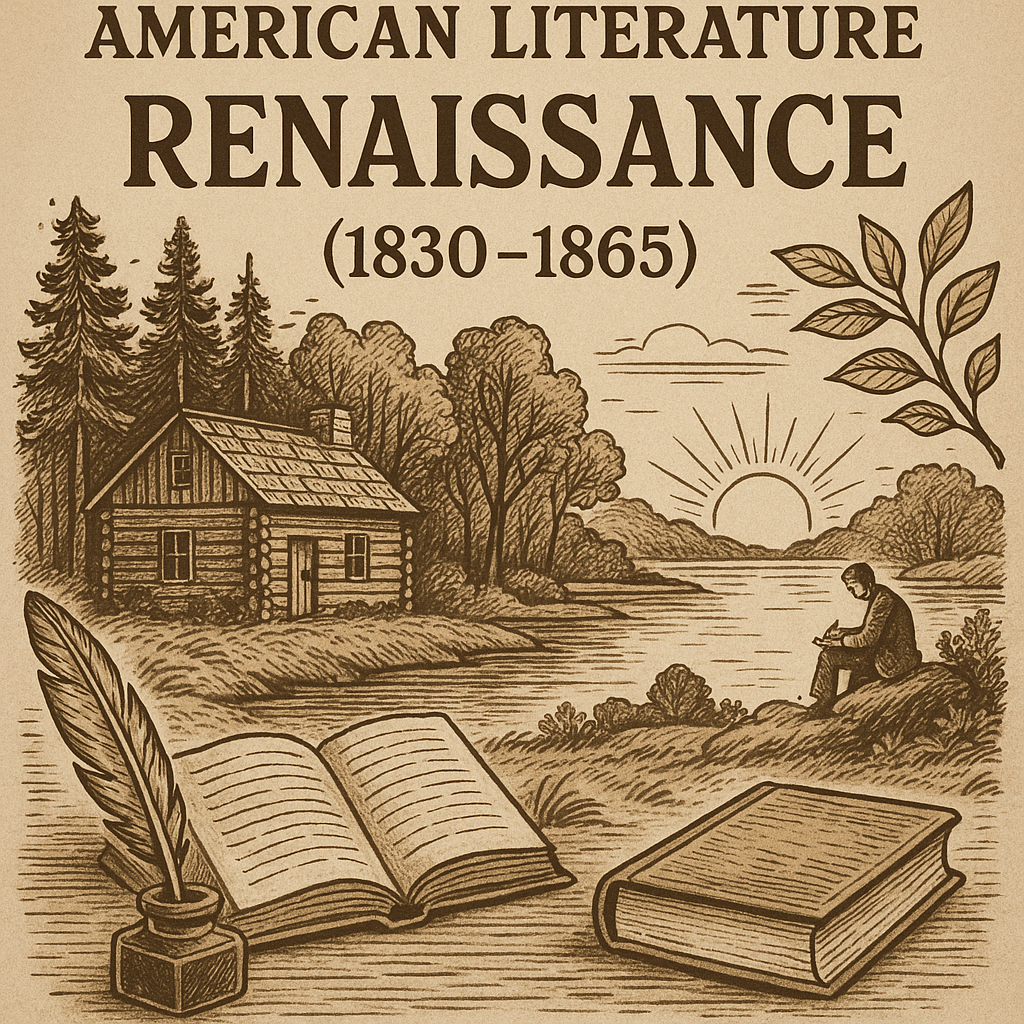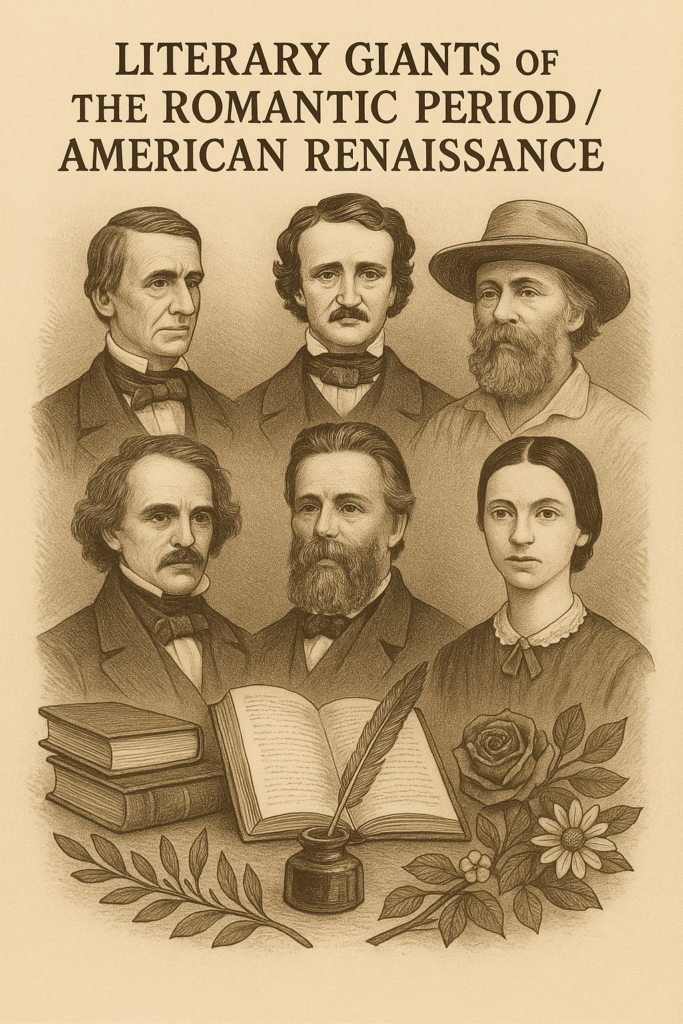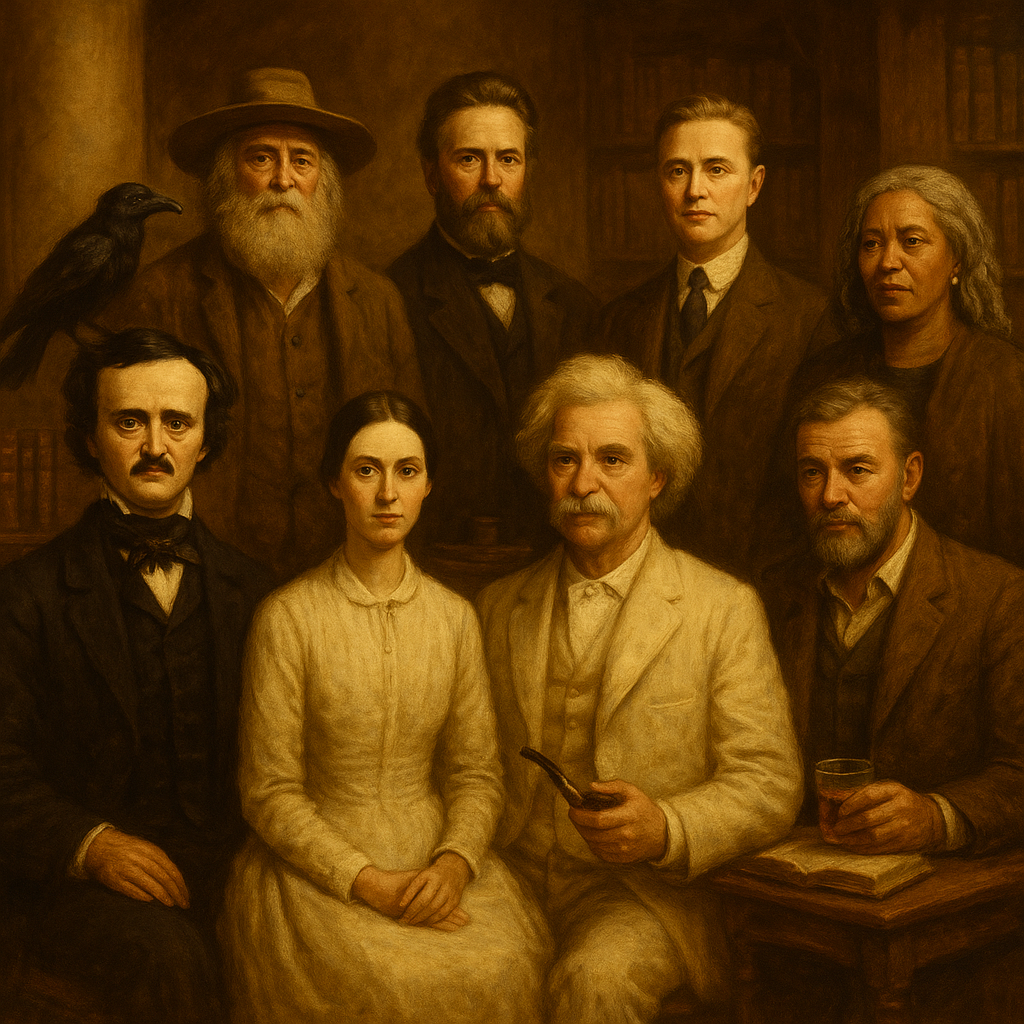Romantic Period in American Literature (1830–1865)
Introduction to the Romantic Period in American Literature
The Romantic Period in American Literature (1830–1865) marks a fundamental transformation in the nation’s literary history. Following the logical, reason-based literature of the Colonial and Early National Period (1607–1830), American writers embraced a new movement. In contrast, this period values emotion, imagination, nature, individualism, and the pursuit of spiritual truths over logic, order, and societal norms. As a result, writers sought to create a unique American voice, moving beyond European influences to reflect the rich and complex fabric of American life.
This era is also called the American Renaissance, as it witnessed a blossoming of American art, philosophy, and writing. Authors began exploring deeper and more diverse subjects, from human psychology and moral dilemmas to mystical experiences and democratic ideals. They rejected rationalism and emphasized personal freedom, introspection, and the power of the individual.

Historical Context of the Romantic Period in American Literature
Several major historical developments shaped the literature of this period:
- Jacksonian Democracy promoted the rights and voices of common people.
- The Industrial Revolution changed labor systems, social structures, and personal values.
- Manifest Destiny encouraged westward expansion and sparked debates over Native American rights and land use.
- Slavery remained a deep moral and political conflict, which led to a rise in abolitionist literature.
- The rise of Transcendentalism brought new philosophical and spiritual insights.
- The Civil War (1861–1865) loomed on the horizon, affecting national consciousness and inspiring literary reflection.
These events deeply influenced American writers, who sought to represent both the hopes and tensions of the age. Their works reflect emotional depth, moral conflict, personal reflection, and imaginative possibilities.
Defining Characteristics of the Romantic Period in American Literature
The Romantic Period brought a distinct set of literary traits. Writers moved away from classical rules and embraced emotional intensity, mystery, and philosophical exploration. The defining characteristics include:
- Emphasis on Emotion and Imagination
Writers explored feelings, dreams, fears, and fantasies. They celebrated emotional experiences as more meaningful than rational thought. Literature during this period often presents intense inner experiences and personal struggles. - Celebration of Nature
Nature appears not just as a setting but as a powerful, spiritual force. Writers connected nature to truth, purity, and emotional healing. Nature often reflects a character’s internal state or spiritual journey. - Focus on Individualism
Writers championed the rights, emotions, and personal journeys of individuals. The individual stood at the center of literary exploration, challenging society, tradition, and institutions. - Fascination with the Supernatural and Mysterious
Literary works frequently included supernatural beings, ghosts, dreams, and unexplained phenomena. Writers used these elements to delve into psychological and moral themes. - Critique of Industrialization
Romantic writers expressed concerns about machines, factories, and modern cities. They viewed industrial progress as a threat to humanity, spirituality, and nature. - Democratic Ideals and National Identity
Literature during this period celebrated democratic values and embraced the diversity that defined America’s cultural landscape. In particular, writers explored the vast and varied geography of the nation, from bustling cities to untamed wilderness. Furthermore, they highlighted the unique experiences of different communities, reflecting the country’s rich cultural mosaic. As a result, American literature began to move away from European models, crafting stories and poems rooted in its own soil. Moreover, these writers contributed significantly to shaping a distinct national literary identity, one that honored freedom, equality, and individuality. Additionally, their works emphasized themes of opportunity and social progress, mirroring the democratic ideals the young nation aspired to uphold. Thus, literature became a powerful tool for expressing America’s evolving values and complexities. Ultimately, this celebration of democracy and diversity laid the foundation for a truly American literary tradition. - Deep Interest in the Past
Many Romantic works delve into historical events, legends, and folklore. Writers often drew inspiration from America’s colonial past, native traditions, and ancient myths.
Key Movements Within the Romantic Period in American Literature
Transcendentalism
Transcendentalism emerged in New England during the 1830s and 1840s. Specifically, it blends idealism, spiritualism, and deep respect for nature. Furthermore, the movement promoted self-reliance, inner truth, and unity with the natural world. In addition, Transcendentalists believed in the inherent goodness of people and nature.
Major figures:
- Ralph Waldo Emerson
- Henry David Thoreau
- Margaret Fuller
- Bronson Alcott
Key works:
- Emerson: Nature, Self-Reliance
- Thoreau: Walden, Civil Disobedience
Dark Romanticism / Gothic Literature
Dark Romanticism explores the irrational, sinful, and grotesque elements of human nature. Unlike the optimistic tone of mainstream Romanticism, this subgenre delves into the shadows of the human psyche. In particular, it includes gloomy settings, haunted characters, and intense psychological themes that unsettle and provoke. Furthermore, writers used these devices to challenge the idealistic views of human nature that dominated much of early American thought. By doing so, they exposed the hidden fears, moral conflicts, and inner turmoil that people often suppress. Consequently, the literature of Dark Romanticism reveals a world where evil, madness, and despair coexist with beauty and hope. Notably, authors like
Major figures:
- Edgar Allan Poe
- Nathaniel Hawthorne
- Herman Melville
Key works:
- Poe: The Raven, The Fall of the House of Usher, The Tell-Tale Heart
- Hawthorne: The Scarlet Letter, The House of the Seven Gables
- Melville: Moby-Dick, Bartleby, the Scrivener
Major Authors of the Romantic Period in American Literature
Ralph Waldo Emerson (1803–1882)
Emerson was the father of American Transcendentalism, and his influence on the movement remains profound. As a leading thinker of his time, he shaped the spiritual and intellectual foundation of the era. Notably, his essays promote individuality, personal growth, and harmony with nature—core values that define Transcendentalist thought. Moreover, Emerson emphasized the importance of self-trust, encouraging individuals to rely on their inner voice rather than conform to societal expectations. In addition, he believed in a universal spirit, often called the “Oversoul,” which he saw as present in all living things. Through this belief, Emerson unified humanity and nature under a shared divine essence. Therefore, his writings encouraged a deep connection between the soul and the natural world. Ultimately, Emerson’s ideas sparked a cultural awakening, inspiring countless readers to seek truth, beauty, and meaning in both the self and the universe.
Famous works: Self-Reliance, The American Scholar, Nature

Henry David Thoreau (1817–1862)
Thoreau lived his philosophy through his famous experiment at Walden Pond, spending over two years in deliberate solitude. Through this experience, he aimed to strip life to its essentials and discover what truly mattered. Consequently, his time at Walden became the foundation for his influential book Walden, inspiring readers worldwide. Moreover, Thoreau advocated simple living, encouraging people to reject material excess and embrace self-reliance. In addition, he stressed environmental awareness, urging a reconnection with nature and a moral duty to protect the earth. Equally important, Thoreau believed in peaceful resistance to injustice, as he wrote in his essay Civil Disobedience. As a result, his ideas influenced leaders like Gandhi and Martin Luther King Jr. Ultimately, Thoreau’s life and writings call for ethical living and harmony with nature.
Famous works: Walden, Civil Disobedience
Edgar Allan Poe (1809–1849)
Poe pioneered psychological horror and detective fiction. He mastered the short story form and used gothic settings and unreliable narrators to explore madness and death.
Famous works: The Raven, The Tell-Tale Heart, The Black Cat, The Masque of the Red Death
Nathaniel Hawthorne (1804–1864)
Hawthorne used symbolism, moral conflict, and Puritan history to explore guilt, sin, and redemption. His characters often suffer under social expectations and inner guilt.
Famous works: The Scarlet Letter, Young Goodman Brown, The House of the Seven Gables
Herman Melville (1819–1891)
Melville wrote powerful sea tales with philosophical depth. His fiction explores obsession, free will, good versus evil, and the complexities of the human mind.
Famous works: Moby-Dick, Billy Budd, Typee, Bartleby, the Scrivener
Walt Whitman (1819–1892)
Whitman revolutionized poetry with his free verse and celebration of the self, democracy, and nature. He merged the personal and political, praising the ordinary and the divine.
Famous works: Leaves of Grass, Song of Myself, I Sing the Body Electric
Emily Dickinson (1830–1886)
Emily Dickinson (1830–1886) led a private life, often retreating from public attention, yet she produced nearly 1,800 poems during her lifetime. Despite her reclusive nature, her work reflects profound emotional insight and intellectual depth. In particular, she explored themes such as death, immortality, love, and the natural world with unmatched originality. Moreover, her unconventional style—marked by dashes, slant rhyme, and fragmented syntax—challenged poetic norms of her time. As a result, Dickinson created a voice both deeply personal and universally resonant. Additionally, her poems pose philosophical questions, inviting readers to reflect on existence, faith, and the mysteries of the afterlife. Unlike many contemporaries, she rarely published during her lifetime, yet her legacy has grown immensely since her death. Ultimately, her work continues to influence modern poets and remains a powerful example of artistic individuality.
Famous works: Because I could not stop for Death, I felt a Funeral in my Brain, Hope is the thing with feathers
Themes Explored in the Romantic Period in American Literature
- Self-Discovery and Individualism
Writers portrayed personal journeys toward self-awareness, often against social norms. - Man’s Connection with Nature
Nature appears as both a setting and a teacher, guiding individuals toward spiritual truths. - Mystery and the Supernatural
Ghosts, dreams, and the unexplained deepen the emotional and moral complexity of narratives. - Critique of Society and Materialism
Many authors rejected industrial values, urbanization, and capitalism. - Moral and Psychological Conflict
Characters often face deep internal dilemmas about right, wrong, guilt, and redemption. - Celebration of Common Life
Poets and storytellers praised ordinary people and daily experiences as worthy literary subjects. - Search for Truth Beyond the Physical
Writers explored spirituality, intuition, and inner truth beyond the observable world.
Influence and Legacy of the Romantic Period in American Literature
The Romantic Period shaped the future of American literature in profound ways:
- It established literary independence from European traditions.
- It created foundational works that continue to shape literary studies and education.
- It inspired future literary movements, including realism, naturalism, and modernism.
- It gave voice to underrepresented themes, such as individual rights, environmental awareness, and psychological complexity.
- It introduced literary techniques still used today, such as unreliable narrators, stream of consciousness, and symbolism.
The works of this period remain relevant and deeply moving, continuing to speak to modern readers across generations. Indeed, they offer more than just historical value; they provide insight into the emotional and intellectual struggles that define the human condition. Moreover, these literary pieces invite readers to explore the complexities of the human spirit, the majesty of the natural world, and the infinite possibilities of the imagination. As a result, the Romantic writers of this era inspire personal reflection, emotional depth, and a heightened awareness of both self and environment. Even today, their messages about individuality, emotional truth, and the power of nature continue to shape the way literature is read and understood.
Conclusion
The Romantic Period in American Literature (1830–1865) stands as a monumental era in the development of American culture. Indeed, it represents a turning point where writers claimed their own identity, rejected strict rationalism, and opened their hearts and minds to creativity, nature, and spiritual truth. Moreover, through the works of Emerson, Thoreau, Poe, Hawthorne, Melville, Whitman, and Dickinson, the spirit of the American Renaissance continues to inspire readers and writers around the world. Ultimately, this era remains a vibrant testimony to the power of literature to reflect and transform the human experience.
Discover more from Welcome to My Site of American Literature
Subscribe to get the latest posts sent to your email.
